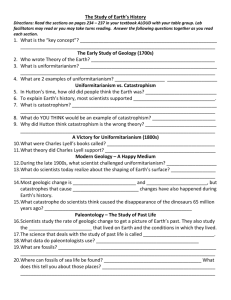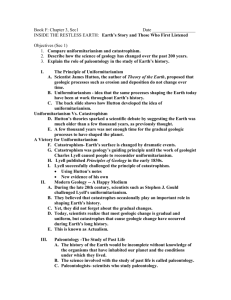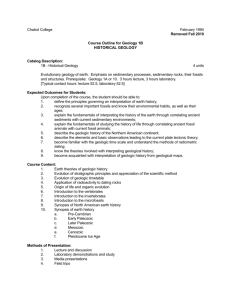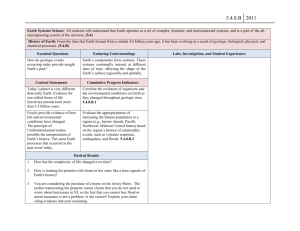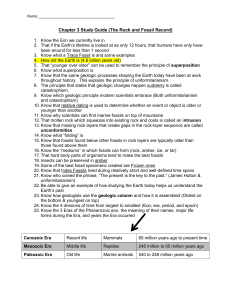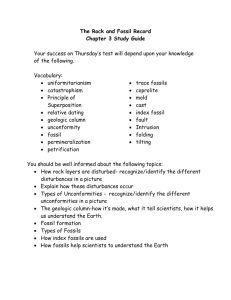Chapter 1 - environment.jbpub.com
advertisement
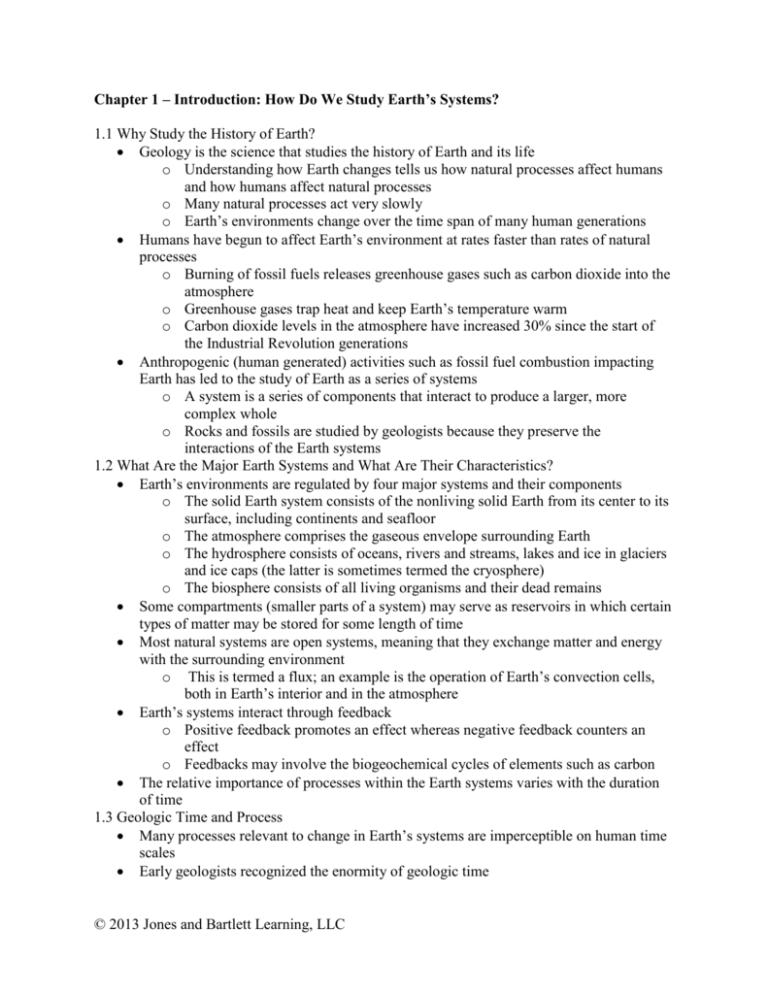
Chapter 1 – Introduction: How Do We Study Earth’s Systems? 1.1 Why Study the History of Earth? Geology is the science that studies the history of Earth and its life o Understanding how Earth changes tells us how natural processes affect humans and how humans affect natural processes o Many natural processes act very slowly o Earth’s environments change over the time span of many human generations Humans have begun to affect Earth’s environment at rates faster than rates of natural processes o Burning of fossil fuels releases greenhouse gases such as carbon dioxide into the atmosphere o Greenhouse gases trap heat and keep Earth’s temperature warm o Carbon dioxide levels in the atmosphere have increased 30% since the start of the Industrial Revolution generations Anthropogenic (human generated) activities such as fossil fuel combustion impacting Earth has led to the study of Earth as a series of systems o A system is a series of components that interact to produce a larger, more complex whole o Rocks and fossils are studied by geologists because they preserve the interactions of the Earth systems 1.2 What Are the Major Earth Systems and What Are Their Characteristics? Earth’s environments are regulated by four major systems and their components o The solid Earth system consists of the nonliving solid Earth from its center to its surface, including continents and seafloor o The atmosphere comprises the gaseous envelope surrounding Earth o The hydrosphere consists of oceans, rivers and streams, lakes and ice in glaciers and ice caps (the latter is sometimes termed the cryosphere) o The biosphere consists of all living organisms and their dead remains Some compartments (smaller parts of a system) may serve as reservoirs in which certain types of matter may be stored for some length of time Most natural systems are open systems, meaning that they exchange matter and energy with the surrounding environment o This is termed a flux; an example is the operation of Earth’s convection cells, both in Earth’s interior and in the atmosphere Earth’s systems interact through feedback o Positive feedback promotes an effect whereas negative feedback counters an effect o Feedbacks may involve the biogeochemical cycles of elements such as carbon The relative importance of processes within the Earth systems varies with the duration of time 1.3 Geologic Time and Process Many processes relevant to change in Earth’s systems are imperceptible on human time scales Early geologists recognized the enormity of geologic time © 2013 Jones and Bartlett Learning, LLC Analysis of layered rock sequences led to the Principle of Superposition and other relative age techniques o James Hutton interpreted the action of processes much slower than those observed on human time scales The Principle of Faunal Succession is based on fossils as evidence for ancient life o It states that different groups of fossils follow each other in a characteristic sequence More recently (during the 20th century), absolute ages were determined from the rates of radioactive decay of certain minerals o The modern geologic time scale incorporates both changes in fossil assemblages and absolute ages The Principle of Uniformitarianism states that processes we observe today have always operated; it underlies all scientific inquiry o Traced to James Hutton but also expressed in writings of earlier scientists o Hutton recognized that natural processes are cyclic and that Earth has an internal source of heat o Charles Lyell developed uniformitariansm to counter castrophism, the view that Earth resulted through processes not observable today o The uniformitarian approach is termed actualism, and considers processes in modern environments as analogs of those in ancient environments o Uniformitarianism is often stated as “the present is the key to the past” but the past is not the key to the present; conditions then may have been quite different from present-day conditions o The current understanding of uniformitarianism is that although processes remain the same, the rates can vary (and the duration of time involved can be important); also, that highly unusual conditions and phenomena such as meteor impacts and mass extinctions occur 1.4 Directionality and the Evolution of Earth Systems Lyell envisioned Earth as being in equilibrium, meaning a system exhibiting no net change through time Evidence exists, however, that Earth has also evolved, meaning that its seemingly equilibrium states have actually shifted through time in particular directions; this is termed secular change Earth’s history has consisted of a succession of vastly different worlds leading up to ours 1.5 Geology as an Historical Science The view of nature and its components as machines dates to Rene Descartes (16th century) o This led to reductionism, the view that nature can be understood by taking it apart, such as breaking the Earth system into components Science is also based on the assumption that each effect has a particular cause o This view is called determinism o The notion that the simplest explanation of a phenomenon is most likely to be correct is called Ockham’s Razor o Earth’s phenomena are not strictly deterministic because the same effect may have multiple or overlapping causes; this is termed multiple causation © 2013 Jones and Bartlett Learning, LLC o The processes that occurred during the ancient past have varied with historical circumstances, or contingency 1.6 The Scientific Method and the Study of Earth’s Evolving Systems According to most scientists, proof is based on formulating and testing hypotheses to see whether or not predictions hold o This method is iterative and self-correcting o Karl Popper, a philosopher who developed the modern scientific method, stated that the best hypotheses are the ones that can be easily falsified o Scientists use procedures of reasoning called induction (in which the conclusion does not necessarily follow from the premises) and deduction (in which the conclusion follows from the premises) to formulate and test hypotheses This approach to science is best exemplified in experimental sciences such as physics and chemistry o Geologists typically test hypotheses by looking for rocks, sediments or fossils and make observations on them on the variables of interest o They then use postdiction (rather than prediction) to reason backward from the geologic data to infer the processes involved Scientists follow the method of multiple working hypotheses in which multiple factors acting on different scales may interact to product a final effect As a hypothesis is tested and confirmed over time it may be elevated to the status of a theory Relationships between phenomena considered to be fundamental truths are called laws o Laws are abstractions; they describe relationships that are repeatable irrespective of contingencies o In geology, general truths are referred to a principles rather than laws © 2013 Jones and Bartlett Learning, LLC
